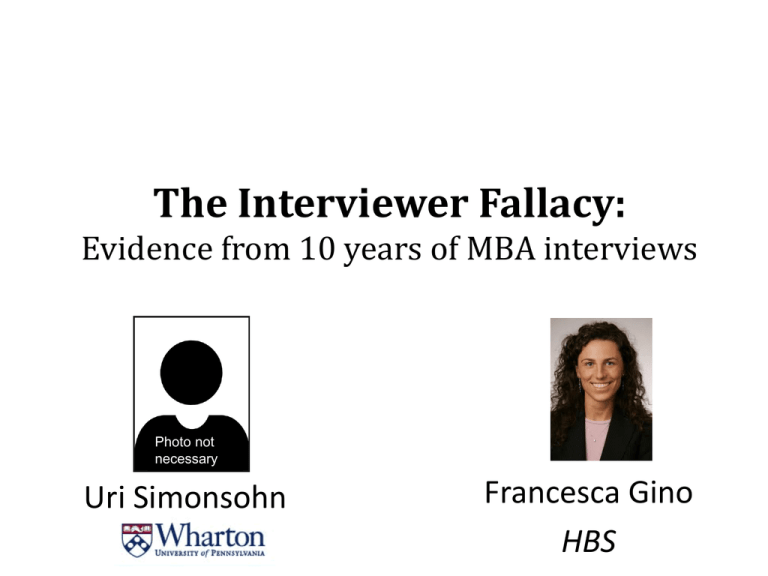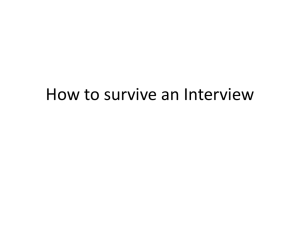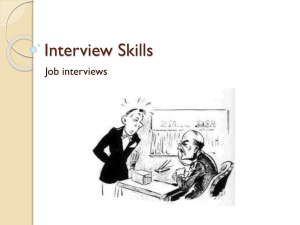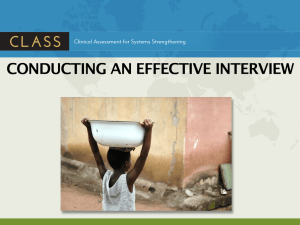The Interviewer Fallacy: Evidence from 10 years of MBA interviews
advertisement

The Interviewer Fallacy: Evidence from 10 years of MBA interviews Photo not necessary Uri Simonsohn Francesca Gino HBS Motivation • How is a journal editor like a venture capitalist? • Continuous flow of judgments “random” “daily” subsets. • Research question: Impact of subsetting? Narrow bracketing +Belief in law of small numbers interviewer fallacy Definition. Reluctance to create subsets of judgments that differ too much from expected distribution. Paper in one slide • Data: 1-5 Rating of MBA interviewees – Handful per day. • corr[avg(so far), this interview]<0 • Ruled out alternatives: – Contrast effects – Non-random sequence Data Description • A business school gave us data • 10 years: N=9,323, k=31 ***INTERRUPT THIS TALK TO COMMENT ON ANOTHER PROJECT*** False-Positive (PsychScience2011): “list all your variables” Naysayers: “love to, have too many” Authors of False-Positive: “really?” Uri: “watch me.” Note: another 22 variables are listed in this page Other side of that single sheet of paper Note: The .pdf weighs 13Kb. The Wharton logo from slide 1: 11kb A hardliner may say: Only reason to choose not to post is to hide information from readers. Back to this talk Data Description • A business school gave us data • 10 years: N=9,323, k=31* – Interviews per day M=4.5, SD=1.9 – Cluster SE [repeated measures] • Info on: – – – – Applicant (e.g, GMAT scores, experience, race, gender) Interviewer identity Interview: time, date Ratings (1-5 likert) • 5 subscores: communication, leader, etc. • Overall score (M=2.9, SD=0.9) • Would like to analyze like gambler fallacy – HHHHpr(T)↑ • Problem – Non-binary data – Covariates – Different interviewers Instead: Scorek,i = OLS(average score so fari , covariates) <0 k: Interviewee, 1 to N that day. i : Interviewer Prediction: (1) Average interview score Given by same interviewer to previous interviewees that day (1-5) (3) (4) Interview Score (1-5) Dependent variable: Specification (2) Baseline Interviewee controls Interview controls Score (1-5) of written application -0.116*** -0.110*** -0.105*** -0.088** (0.038) (0.035) (0.036) (0.035) 0.244*** 0.250*** 0.079** (0.036) (0.035) (0.032) 0.324*** 0.319*** 0.254*** (0.057) (0.055) (0.055) GMAT score of applicant (/100) Months of job experience of applicant (/100) Number of interviews by same interviewer that day Total So far -0.000 0.001 (0.012) (0.012) -0.018 -0.010 (0.013) (0.014) Score given by reader of application 0.340*** (0.044) Other controls Month*year dummies (k=12*9) Interviewer dummies (k= 21) Interviewee gender, race (k=9), age & age-squared Interview's time (k=12) & location (k=4) Yes Yes No No Yes Yes Yes No Yes Yes Yes Yes Yes Yes Yes Yes Effect Size • Average interview 1 point higher, • Equivalent to losing: – 40 GMAT points, or – 30 months of experience. Alternative Explanations • Contrast effects • Non-random sequencing of interviews Contrast vs. Interviewer Fallacy Two divergent predictions: 1) Same effect on the interview subscores? Explanation Prediction Contrast: Int.Fallacy: yes, and stronger no, or at least weaker. Data: - Every one of five subscores: n.s. - Average a-la Robyn Dawes: n.s. - Biggest point estimate, ¼ as big - one is >0 Contrast vs. Interviewer Fallacy Two divergent predictions: 2) Effect as end of day approaches. Explanation Prediction Contrast: Int.Fallacy: weaker (arguably) stronger (absolutely) Data: Estimate same regressions for: • last interview of day • 1 interview left • 2 interviews left Effect of previous interviews as day’s end approaches Alternative Explanations • Contrast effects • Non-random sequencing of interviews • If better candidates follow bad ones or vice-versa spurious finding. • Can we predict objective quality with average-interview-score-so-far? • Test: GMAT=OLS(avg.score) Job Experience = OLS(avg.score) Same table + 2 new columns (1) Average interview score Given by same interviewer to previous interviewees that day (1-5) (3) (5) (6) PLACEBOS GMAT (250-800) Experienc (in months Same as (3) Same as (3) Baseline Interviewee controls Interview controls Score (1-5) of written application -0.116*** -0.110*** -0.105*** -0.088** 0.085 0.251 (0.038) (0.035) (0.036) (0.035) (2.063) (0.959) 0.244*** 0.250*** 0.079** -- 1.140** (0.036) (0.035) (0.032) -- (0.495) 0.324*** 0.319*** 0.254*** 10.363** -- (0.057) (0.055) (0.055) (4.541) -- GMAT score of applicant (/100) Months of job experience of applicant (/100) Number of interviews by same interviewer that day Total So far -0.000 0.001 0.845 0.504* (0.012) (0.012) (0.676) (0.290) -0.018 -0.010 -0.461 0.008 (0.013) (0.014) (1.275) (0.360) 0.340*** 24.190*** (0.044) (1.719) Yes Yes Yes Yes Yes Yes Yes Yes Score given by reader of application Other controls Month*year dummies (k=12*9) Interviewer dummies (k= 21) Interviewee gender, race (k=9), age & age-squared Interview's time (k=12) & location (k=4) (4) Interview Score (1-5) Dependent variable: Specification (2) Yes Yes No No Yes Yes Yes No Yes Yes Yes Yes Yes Yes Yes Yes Possible Mechanisms 1) Gambler fallacy + confirmation bias 2) Mental Accounting 3) Accountability A note on the internal validity of non-lab data • In the lab: hard to study interviewer fallacy • Participants could be learning about – Scale use – Distribution of underlying stimuli quality • Some psychological questions are better studied outside the lab. • This seems likes one of them.










